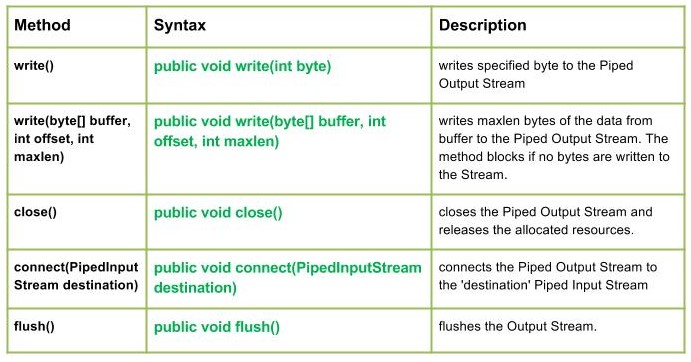
管道IO 提供了 JVM 中同时运行的两个线程之间的链接。因此,管道既可以用作源也可以用作目标。
- PipedInputStream 也通过 PipedOutputStream 进行管道传输。因此,可以使用 PipedOutputStream 写入数据,也可以使用 PipedInputStream 写入数据。但是,同时使用两个线程将会导致线程死锁。
- PipedOutputStream 是管道的发送端。数据写入 PipedOutputStream。如果读取数据的 PipedInputStream 不再存在,则称管道已损坏。
声明:
public class PipedOutputStream
extends OutputStream
构造函数:
- PipedOutputStream():创建一个 PipedOutputStream,它未连接。
- PipedOutputStream(PipedOutputStream inStream):创建一个 PipedOutputStream,它
连接到PipedInputStream - ‘inStream’。
方法:
write(): java.io.PipedOutputStream.write(int byte)将指定字节写入管道输出流。
用法:
public void write(int byte)
Parameters :
byte : byte to be written
Return : void
Exception :
-> IOException : if in case IO error occurs.
write(byte[] buffer, int offset, int maxlen): java.io.PipedOutputStream.write(byte[] buffer, int offset, int maxlen)将 maxlen 个字节的数据从缓冲区写入管道输出流。如果没有字节写入 Stream,则该方法将阻塞。
用法:
public void write(byte[] buffer, int offset, int maxlen)
Parameters :
buffer : data of the buffer
offset : starting in the destination array - 'buffer'.
maxlen : maximum length of array to be read
Return : void
Exception :
-> IOException : if in case IO error occurs.
Java
// Java program illustrating the working of PipedInputStream
// write(byte[] buffer, int offset, int maxlen)
import java.io.*;
public class NewClass
{
public static void main(String[] args) throws IOException
{
PipedInputStream geek_input = new PipedInputStream();
PipedOutputStream geek_output = new PipedOutputStream();
// Use of connect() : connecting geek_input with geek_output
geek_input.connect(geek_output);
byte[] buffer = {'J', 'A', 'V', 'A'};
// Use of write(byte[] buffer, int offset, int maxlen)
geek_output.write(buffer, 0, 4);
int a = 5;
System.out.print("Use of write(buffer, offset, maxlen) : ");
while(a>0)
{
System.out.print(" " + (char) geek_input.read());
a--;
}
}
}输出:
Use of write(buffer, offset, maxlen) : J A V A
- close(): java.io.PipedOutputStream.close()关闭管道输出流并释放分配的资源。
用法:
public void close()
Parameters :
--------------
Return :
void
Exception :
-> IOException : if in case IO error occurs.
- 连接(PipedInputStream 目的地): java.io.PipedOutputStream.connect(PipedInputStream 目的地将管道输出流连接到 ‘destination’ 管道输入流,如果 ‘destination’ 是带有其他流的管道,则会引发 IO 异常
用法:
public void connect(PipedInputStream destination)
Parameters :
destination : the Piped Input Stream to be connected to
Return :
void
Exception :
-> IOException : if in case IO error occurs.
- flush(): java.io.PipedOutputStream.flush()刷新输出流。
用法:
public void flush()
Parameters :
------------
Return :
void
Exception :
-> IOException : if in case IO error occurs.
说明 PipedOutputStream 类方法工作的 Java 代码:
Java
// Java program illustrating the working of PipedInputStream
// write(), write(byte[] buffer, int offset, int maxlen),
// close(), flush(), connect()
import java.io.*;
public class NewClass
{
public static void main(String[] args) throws IOException
{
PipedInputStream geek_input = new PipedInputStream();
PipedOutputStream geek_output = new PipedOutputStream();
try
{
// Use of connect() : connecting geek_input with geek_output
geek_input.connect(geek_output);
// Use of write(int byte) :
geek_output.write(71);
geek_output.write(69);
geek_output.write(69);
geek_output.write(75);
geek_output.write(83);
// Use of flush() method :
geek_output.flush();
System.out.println("Use of flush() method : ");
int i = 5;
while(i > 0)
{
System.out.print(" " + (char) geek_input.read());
i--;
}
// USe of close() method :
System.out.println("\nClosing the Output stream");
geek_output.close();
}
catch (IOException except)
{
except.printStackTrace();
}
}
}输出:
Use of flush() method :
G E E K S
Closing the Output stream
相关用法
- Java Java.io.PipedOutputStream.close()用法及代码示例
- Java Java.io.PipedOutputStream.connect()用法及代码示例
- Java Java.io.PipedOutputStream.flush()用法及代码示例
- Java Java.io.PipedOutputStream.write()用法及代码示例
- Java Java.io.PipedInputStream.available()用法及代码示例
- Java Java.io.PipedInputStream.close()用法及代码示例
- Java Java.io.PipedInputStream.connect()用法及代码示例
- Java Java.io.PipedInputStream.read()用法及代码示例
- Java Java.io.PipedReader.close()用法及代码示例
- Java Java.io.PipedReader.connect()用法及代码示例
- Java Java.io.PipedReader.read()用法及代码示例
- Java Java.io.PipedReader.ready()用法及代码示例
- Java Java.io.PipedWriter.close()用法及代码示例
- Java Java.io.PipedWriter.connect()用法及代码示例
- Java Java.io.PipedWriter.flush()用法及代码示例
- Java Java.io.PipedWriter.write()用法及代码示例
- Java Java.io.PipedReader用法及代码示例
- Java Java.io.PipedWriter用法及代码示例
- Java Java.io.PipedInputStream用法及代码示例
- Java Java.io.PrintStream.append()用法及代码示例
- Java Java.io.PrintStream.checkError()用法及代码示例
- Java Java.io.PrintStream.clearError()用法及代码示例
- Java Java.io.PrintStream.close()用法及代码示例
- Java Java.io.PrintStream.flush()用法及代码示例
- Java Java.io.PrintStream.format()用法及代码示例
注:本文由纯净天空筛选整理自佚名大神的英文原创作品 Java.io.PipedOutputStream Class in Java。非经特殊声明,原始代码版权归原作者所有,本译文未经允许或授权,请勿转载或复制。
